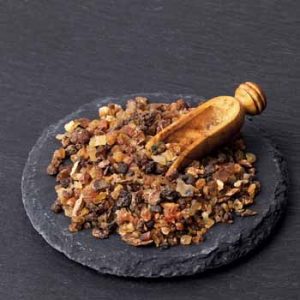
More evidence that low-calorie sweeteners are bad for your health
Studies show that artificial sweeteners can raise the risk of hypertension, metabolic syndrome, type 2 diabetes and heart disease, including stroke.

Asked to name the essential oils that seem to sum up the essence of the winter season, most people would include myrrh on their list.
But how much do you really know about myrrh and its many uses?
Like its more well-known cousin, frankincense, myrrh is a desert plant native to Northern Africa and the Middle East, and in particular Somalia, Ethiopia, Arabia, and Yemen. Also like frankincense the small thorny trees (Commiphora myrrha) that it comes from produces a sticky oleoresin, a mixture of resin and essential oils that have a long use in maintaining health.
» Myrrh has a long list of traditional uses for fighting infection and promoting health.
» Modern science has confirmed that its antimicrobial and wound healing properties make it a particularity useful ingredient for maintaining dental and skin health.
» Further evidence shows myrrh has promise as an antioxidant and even in some cancer research.
To harvest the myrrh, an incision is made in the bark of the tree that allows the resin to seep out. Exposed to the air it hardens making collection easier. The dried lumps of resin are then steam-distilled to produce the essential oil which has a unique smoky, balsamic aroma.
Traditional uses
The word “myrrh” comes from “murr,” which means “bitter” in Arabic, probably referring to the resin’s bitter taste. Although it was once used as a preservative for wine, most of us encounter Myrrh as a resin – which can be burned like incense – and more commonly as the essential oil.
Myrrh is a traditional healer. Along with gold and frankincense it was one of the gifts of the Magi to the newborn Jesus – suggesting that it was at least as valuable as gold to ancient civilisations. Myrrh has been used as incense and a holy oil in religious rituals and ceremonies for over 5,000 years. The Egyptians used it for embalming but also to treat hay fever and herpes. The ancient Greeks used it as an antiseptic for soldiers to clean up battle wounds.
Today, modern science is confirming many of these ancient uses.
Dental health
Myrrh’s antiseptic properties make it an excellent mouthwash ingredient to treat infection or inflammation including mouth ulcers, sore throat, bleeding inflamed gums, bad breath and thrush. As a result some natural toothpastes and mouthwashes now incorporate myrrh into their ingredients.
A review conducted by Egyptian researchers, myrrh “is one of the most effective herbal medicines in the world for sore throats, canker sores and gingivitis.”
In another study, a gel made from aloe and myrrh was effective in treating minor recurrent mouth ulcers. According to the researchers the aloe helped decrease ulcer size, erythema, and exudation; whereas myrrh resulted in more pain reduction.
Skin healing
A traditional skin treatment, myrrh has a reputation for delaying wrinkles and other signs of ageing. Many skin products for both men and women now include myrrh as an ingredient.
Strong antimicrobial properties, in combination with its ability to relive pain and reduce inflammation, makes myrrh a good choice for healing wounds.
In one study a combination of frankincense and myrrh was found to work synergistically to kill harmful bacterial infections Cryptococcus neoformans and Pseudomonas aeruginosa.
In another myrrh was one of several essential oils, applied as a soap or in a sitz bath, that helped heal the perineum in new mothers after an episiotomy. Try using it with a cold compress to relieve sores and wounds to help accelerate healing.
Respiratory infections
Myrrh essential oil is good against coughs and colds. It fights the viral infections that can cause coughs and colds, as well as relieving congestion and reducing phlegm in the lungs and respiratory tract. Try using it in an essential oil burner to clean the air in a sick room, as a steam inhalation to help loosen phlegm or as a chest rub (make a 2% dilution by adding 12 drops of myrrh oil to each fl. ounce (30 ml, 2 tbls of a light carrier such as almond oil).
Digestion
Massaged over the abdomen, myrrh can help improve circulation and is an effective treatment for sluggish digestion and wind. tT is also good for diarrhoea caused by a chill. Make a 2% dilution as above.
Other benefits
Research is pointing the way towards other benefits as well.
For example, a 2010 study found that extract of a particular type of myrrh (Commiphora molmol) was able to protect the liver from the toxic effects of lead.
Other evidence suggests that myrrh may have cholesterol lowering properties, though not all trials have shown this effect.
Myrrh has been shown to kill cancer cells in laboratory conditions, though it has not yet been shown in humans.
Tests by US researchers show that it may have promise for the prevention and treatment of breast and prostate cancer. Another study conducted by Chinese researchers likewise found that extracts made from myrrh resin may be effective against human gynaecologic cancer cells.
The majority of people can use myrrh without any problem, though in some it can cause a sensitivity reaction. If you are prone to skin sensitivity, always do a patch test first. To do this dilute 4 drops of essential oil in a teaspoon of base oil. Apply 1-2 drops of the diluted mixture onto the skin inside your elbow. Cover with a bandage and leave for 24 hours (don’t let it get wet) to assess whether there is any reaction.

Please subscribe me to your newsletter mailing list. I have read the
privacy statement